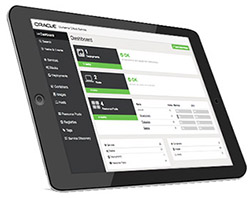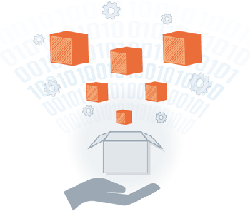Oracle's Latest Container Clouds Aim To Make DevOps Open and Easy
Oracle is making it easier for companies to bring disruptive apps to life by bringing together several core ingredients – clouds, containers and PaaS. IDN speaks with Oracle execs about its latest Oracle Cloud updates -- Oracle Container Cloud Service and Oracle Application Container Cloud Service.

senior vp & general mgr
integration products

"Oracle now has a full-featured cloud-based ‘container-as-a-service’ platform that provides a quick and easy way to create an enterprise-grade container infrastructure."
As Uber, Netflix and other disruptive apps continue to showcase how innovative IT can lead to game changers for business, more integration developers are taking notice – and want to get on-board. Oracle is making it easier for companies to bring disruptive apps to life by bringing together several core ingredients – clouds, containers and PaaS.
IDN speaks with Oracle execs about its latest Oracle Cloud updates, the Oracle Container Cloud Service and Oracle Application Container Cloud Service.
“When people first talked about ‘composite apps’ a few years ago, the view was mostly about simply adding in, or integrating, a new UI or UX onto the app,” Amit Zavery, Oracle’s senior vice president and general manager of integration products told IDN. “But today, integration capabilities and containers are at the heart of a new model for creating composite apps, like Uber, that can deliver huge benefits to the business.”
Unfortunately, it is also a bit complicated for many companies. “Not everyone is ready to undertake building such apps. Containers can prove to be complicated and a lot of hard work. And even after these apps are built, it can be really painful to maintain and update them,” he added.
So, the Oracle Container Cloud Service – the latest addition to the growing Oracle Cloud Service family – looks to lower that complex bar for many companies. “We now have a full-featured cloud-based ‘container-as-a-service’ platform that provides a quick and easy way to create an enterprise-grade container infrastructure,” Zavery added.
The Oracle Container Cloud Service and management platform aims to provide an easy-to-adopt, full featured container infrastructure from the cloud. It is designed to help enterprises deploy, administer, monitor, and orchestrate services (or stacks of services) as Docker containers – and achieve all this across multiple hosts. Beyond that, OCCS lets users scale them as needed.
The result Users have an easier way to follow in the footsteps of Uber, Netflix and others in using container-based development, testing, staging and production for innovative and agile apps, Zavery added.
Many OCCS’s features and benefits are designed to let users:
- Create the Docker container infrastructure that you need— when you need it.
- Allow users to segment their infrastructure into different pools of compute resources. The idea of this ‘resource pool; capability is to let users run different apps in each pool or to use each pool for a separate function in the development lifecycle
- Provide and provision individual instances to each team member. Each instance set its list of authorized users.
- Create any-sized environment for test, production and scale. This flexibility allows users to set the size and shape of the VMs and hosts needed – and only pay for what is used.
- Support wide technology choice, thanks to its use of Docker Compose-like YAML files to describe an app and how it’s deployed. Files are simple to import, export, and share.
- Achieve deployment flexibility by bringing their own containers (including open source). Or, if new to Docker, users can start with a pre-defined example (e.g. web servers, databases such as MySQL and Mongo, and more). Users can also work with a variety of languages, databases, web apps, monitoring and logging tools.
- Speed up deployment and run capabilities, thanks to a host of features, including:
- A GUI and a CLI to give users the choice of a visual point and click experience or a fully scriptable, highly automated DevOps experience
- Built-in performance metrics and dashboards to let IT ops see host performance metrics and container health checks.
- Docker event audit logs and container logs, which lets users view these events and container logs on-screen.
- Self-healing application deployments, designed to continually maintain the running state of an app. In this case, OCCS can restart the container automatically if it fails.
- Completely isolate each service to run in its own. So, if a service starts “acting up” it will not affect the other services.
- Simplify orchestration and management with several ‘out-of-the-box’ example apps. These apps let users (1) create one-click deployments; (2) enable built-in service discovery; (3) Import existing Docker run and Docker compose files; (4) copy and paste app YAML to encourage code sharing and cross-team collaboration; and (5) scale containerized apps as needed.

Taken together, Zavery said the goal is to present a rich set of services to use containers and cloud services to create and run innovative apps “You now can more easily create an app like Uber because you have a platform that supports a composite ‘experience’ -- all the way up from the very base layer of your app. You can use cloud and containers to design an app where a lot of different services are working together in real-time,” he said.
Oracle’s Vision of Benefits from Cloud & Containers
“Using containers, developers can now define services in much more granular (and reusable) ways,” Mike Lehmann, Oracle’s vice president for product management told IDN. And because Oracle’s Container Cloud Service solution is designed to seamlessly work with the suite of Oracle Cloud platform service, “users can integrate services (and microservices) together in more intuitive ways.”
“The way we thought about it is, a lot of developers want to build these lighter-weight microservices-style apps that pull together collection of services. So, our fundamental design principal is API-first, very lightweight, with an integrated DevOps-driven cycle behind it,” Lehmann explained.
Oracle also provides some guidance for those that may be looking for it. “We do that by providing a proscriptive PaaS – we call it the Oracle Application Container Cloud Service - on top of the base Container Cloud where we help developers implement best practices such as 12 factor application development techniques – DevOps automation, explicit declaration of dependencies, externalization of state, autoscaling and more – to enable very agile application development and deployment,” Lehmann said.
Designed as a cloud-native polyglot platform, developers can use Java SE, Node.js, PHP, as well as leverage any of the tens of thousands of libraries, frameworks, and modules available for Java, PHP and Node as they choose to further simplify and accelerate application development.
As a result, using the Oracle Application Container Cloud Service platform, users can create microservices and create a user experience very quickly. This easier-to-use modular approach means more companies can create what Lehmann called “more responsive, user-centric apps that can adapt to how they use multiple services and containers, even in real-time to adjust to user activity.”
Taken as a duo,, the combination of Application Container Cloud Service and Container Cloud Service is key, Lehmann added, because it gives developers flexibility in how they choose to work with containers. They can take total 100% control with OCCS – or choose a more high productivity prescriptive PaaS with ACCS to automate some steps to speed things up.
Lehmann explained it this way:

“We can support high-control style developers -- those that want ultimate control and freedom to build their own containers, own exactly how things are laid out and join them together in whatever fashion they’d like. So, they can choose their language, their favorite scripting framework, and so on,” he added. As an example, a user might opt for ultimate control when the project goes hyperscale – 1,000 or more containers behind an e-commerce site. “In that kind of large example, you frequently want full control of those containers.”
On the other hand, where the architecture is so not so large – say 50-100 containers – a user might be willing to trade off control to focus more on productivity and agility. With the Application Container Cloud Service, where curated runtimes are available, container generation is automated and things like autoscaling are built in, Lehmann added.
“That’s where Oracle Cloud differentiates. We let you walk that continuum. Today, most businesses will want a mix, and we can provide that,” Lehmann said, adding a customer example:
“I was speaking to a customer, and half the conversation was around Kubernetes, Docker and the [Oracle] Container Cloud level where they want Docker to run a portion of their existing data center workloads with maximum control over those containers. The other half was how they were going live with their portal on their polyglot microservice aPaaS (based on Docker), because that was a more productive path to getting a customer-facing portal without the need to dive in at a lower level of full control of the individual Docker containers.”
That user anecdote is important to Lehmann because, as he told IDN, “that mix to me is what modern app dev looks like. And, that’s why Oracle sees it as important to have several levels of [Oracle Cloud Services] working together.”
The OCCS is at the core IaaS layer, the other two are:
- A high-productivity PaaS or aPaaS (application platform-as-a-service) – the Application Container Cloud Service - for building rapid time-to-market microservices.
- An iPaaS (integration PaaS) to tie together backend SaaS and on-prem (pushing or exposing through an API platform. “Microservices, and apps that use them, will also often need to plug into backend apps. So, to avoid the need to write custom integration code, we can provide you an iPaaS-like experience” to make that level of integration tasks much easier.
“Many customers are telling us they want more disruptive and agile apps -- and see the use of IaaS, aPaaS and iPaaS as a key way to get there,” Zavery said. But, these same customers, he added also tell Oracle they want more than raw container componentry – “Customers want to get started quickly and see results quickly. So, they want guidance, automation and the flexibility to adopt containers at their own speed. We’re seeing Oracle’s approach, which offers a combination of technologies and automation, and all of which works with Oracle Cloud platform, becoming a key enabler."
To learn more about Oracle Container Cloud Service and Oracle Application Container Cloud Service, Oracle will be holding a series of Oracle Code live events throughout the country in the coming months.



